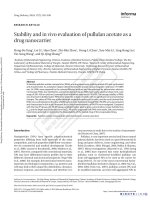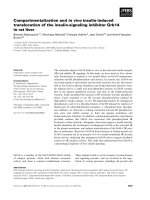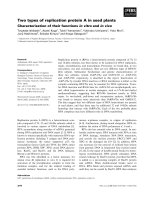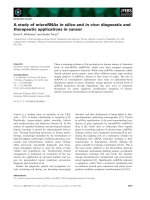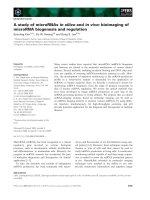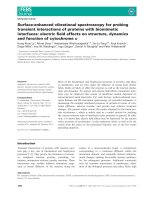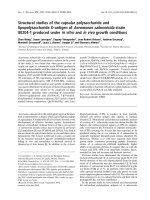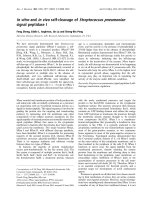ENCAPSULATION OF PLATINUM BASED DERIVATIVES WITHIN CARBON NANOTUBES INVESTIGATIONS ON CONTROLLED RELEASE AND IN VIVO BIODISTRIBUTION
Bạn đang xem bản rút gọn của tài liệu. Xem và tải ngay bản đầy đủ của tài liệu tại đây (6.37 MB, 258 trang )
ENCAPSULATION OF
PLATINUM-BASED DERIVATIVES
WITHIN CARBON NANOTUBES:
INVESTIGATIONS ON CONTROLLED RELEASE
AND IN VIVO BIODISTRIBUTION
LI JIAN
(B.S., Shanghai Jiao Tong University)
A THESIS SUBMITTED
FOR THE DEGREE OF DOCTOR OF PHILOSOPHY
DEPARTMENT OF PHARMACY
NATIONAL UNIVERSITY OF SINGAPORE
2012
DECLARATION
I hereby declare that this thesis is my original
work and it has been written by me in its entirety.
I have duly acknowledged all the sources of
information which have been used in the thesis.
This thesis has also not been submitted for any
degree in any university previously.
___________________________
LI JIAN
29 DEC 2012
i
Acknowledgements
This dissertation would not have been possible without the guidance and the help of
several individuals who in one way or another contributed and extended their
valuable assistance in the preparation and completion of this study.
First and foremost, I would like to express my sincere gratitude to my supervisor,
Prof PASTORIN Giorgia, Associate Professor, Department of Pharmacy, National
University of Singapore, for the continuous support of my Ph.D. study and research,
for her patience, encouragement, enthusiasm, constructive comments, and immense
knowledge.
Besides my supervisor, I would like to thank Prof ANG Wee Han, Assistant Professor,
Department of Chemistry, National University of Singapore, for kindly providing
platinum(IV) compounds, and Prof RAMAPRABHU Sundara, Indian Institute of
Technology, Madras, India, for providing ultrapure multi-walled carbon nanotubes
for my research.
My warmest thanks also go to Prof HO Chi Lui, Prof LEONG Tai Wei, and Prof
YAN Bing, for taking time to be my Ph.D. examiners.
I am deeply grateful to Mr CHONG Ping Lee and Ms LOY Gek Luan, Department of
Biology, National University of Singapore, for guidance on transmission electron
microscopy; Ms LENG Lee Eng and Ms TAN Tsze Yin, Department of Chemistry,
National University of Singapore, for helping perform thermogravimetric analysis
and inductively coupled plasma optical emission spectrometry; Dr AL-HADDAWI
Muthafar, Institute of Molecular and Cell Biology, Singapore, for offering the
consultation on histopathological analysis.
ii
I would like to thank the Department of Pharmacy, National University of Singapore,
for granting me the scholarship that allowed me to pursue this study, and for
providing the premises and equipments for me to conduct the experiments. I would
also like to thank Prof CHUI Wai Keung (Head of the Department), Prof CHAN Sui
Yung (former Head of the Department), and all other faculty members of Department
for their cooperation whenever I needed.
I would like to express my sincere gratitude to the colleagues and fellows in my
laboratory and department. They are Ms CHAN Wei Ling, Dr CHEONG Siew Lee,
Ms CHEW Ying Ying, Mr CHIN Chee Fei, Mr GOH Min-Wei, Mr HU Jun, Mr
Johannes Murti Jaya, Ms LIM Wan Min, Ms LYE Pey Pey, Dr MANDEL Alex, Ms
NAM Wan Chern, Ms Napsiah Binte Suyod, Dr NAYAK Tapas Ranjan, Ms NG Sek
Eng, Ms Nor Hazliza Binte Mohamad, Ms OH Tang Booy, Ms PANT Aakanksha, Dr
PRIYANKAR Paira, Dr REN Yupeng, Mr SHAO Yi-Ming, Dr TIAN Quan, Mr
VENKATA Sudheer Makam, Mr VENKATESAN Gopalakrishnan, Mr
WIRATAMA CHANDRA Gary, Ms YAP Siew Qi, Ms YONG Sock Leng, Ms
YOONG Sia Lee, and Ms ZHAO Chunyan.
Last but not the least, I would like to thank my family for giving birth to me at the
first place and offering understanding, encouragement, and support throughout my
life.
iii
Table of Contents
Acknowledgements i
Table of Contents iii
Summary xi
List of Tables xiv
List of Figures xv
List of Illustrations xviii
List of Abbreviation xix
List of Publications and Conference Presentations xxvii
Chapter 1 Introduction 1
1.1 Nanotechnology and nanomaterials 1
1.1.1 Overview of nanotechnology 1
1.1.2 Nanotechnology in medicine 2
1.1.3 Nanotechnology in drug delivery 4
1.2 Carbon nanotubes 6
1.2.1 Background and general applications of carbon nanotubes 6
1.2.2 Carbon nanotubes in drug delivery 8
1.2.2.1 CNT-based drug delivery system through chemistry
attachment 10
1.2.2.2 CNT-based drug delivery system through π-π stacking
interactions 13
1.2.2.3 CNT-based drug delivery system through incorporation into
inner cavity 17
1.3 The biocompatibility of carbon nanotubes in drug delivery 22
1.3.1 Toxicity issues of carbon nanotubes towards biological systems . 22
1.3.1.1 Purity of carbon nanotubes 23
iv
1.3.1.2 Toxicity reports on carbon nanotubes 26
1.3.1.2.1 In vitro toxicity study on carbon nanotubes 26
1.3.1.2.2 In vivo toxicity study on carbon nanotubes 26
1.3.1.2.3 Elimination of carbon nanotubes from biological
systems 28
1.3.1.2.4 Correlation between toxicity and administrated dose
as well as exposure time 30
1.3.1.3 Toxicity-related factors of carbon nanotubes 31
1.3.1.3.1 Metal impurities 31
1.3.1.3.2 Carbon nanotubes’ structure 32
1.3.1.3.3 Carbon nanotubes’ length 33
1.3.1.3.4 Carbon nanotubes’ aspect ratio 34
1.3.1.3.5 Carbon nanotubes’ diameter 35
1.3.1.3.6 Carbon nanotubes’ surface properties 36
1.3.1.3.7 Carbon nanotubes’ charge 37
1.3.2 Biocompatibility improvement of carbon nanotubes 37
1.3.2.1 Non-covalent coating 38
1.3.2.2 Covalent binding 41
1.4 Conclusion 46
Chapter 2 Hypothesis and Objectives 47
2.1 Thesis rationale and hypothesis 47
2.2 Objectives 48
Chapter 3 Carbon Nanotubes for Incorporation, Storage and Release of Cisplatin 51
3.1 Introduction 51
3.1.1 Anticancer drug cisplatin 51
3.1.2 Rationale of nano-extraction and nano-condensation 53
3.1.3 Selective washing of CNTs with guest molecules 56
3.2 Hypothesis and objectives 57
v
3.3 Materials and methods 58
3.3.1 Chemicals and reagents 58
3.3.2 Instruments 58
3.3.3 Methods 59
3.3.3.1 Entrapment of CDDP within MWCNTs via nano-extraction
and nano-condensation methods 59
3.3.3.1.1 Dispersibility test of carbon nanotubes 59
3.3.3.1.2 Solubility test of CDDP 59
3.3.3.1.3 Screening of “washing solvent” 60
3.3.3.1.4 Encapsulation of CDDP in MWCNTs 60
3.3.3.1.4.1 Nano-extraction method 60
3.3.3.1.4.2 Nano-condensation method 61
3.3.3.2 Characterization of MWCNT-CDDP 61
3.3.3.2.1 Transmission Electron Microscopy (TEM) 61
3.3.3.2.2 Quantification of encapsulated CDDP using TGA
and ICP-OES 62
3.3.3.3 In vitro release of CDDP from MWCNT-CDDP complex 62
3.4 Results and discussion 63
3.4.1 Dispersibility of carbon nanotubes 63
3.4.2 Solubility of CDDP 65
3.4.3 Screening of “washing solvent” for selective cleaning of
MWCNT-CDDP 66
3.4.4 Characterization of MWCNT-CDDP 67
3.4.4.1 TEM imaging of MWCNT-CDDP 67
3.4.4.2 Quantification of CDDP entrapped within MWCNTs using
TGA and ICP-OES 71
3.4.4.3 SEM-EDX characterization of MWCNT-CDDP 74
3.4.5 In vitro release of CDDP from MWCNT-CDDP in neutral and
weakly acidic conditions 75
vi
3.5 Conclusion 77
Chapter 4 Carbon Nano-bottles Capped by Gold Nanoparticles for Controlled Release
and Enhanced Cytotoxic Effect of Cisplatin 78
4.1 Introduction 78
4.1.1 “Carbon nano-bottle” structure for drug storage 78
4.1.2 Use of gold nanoparticles as “caps” 81
4.2 Hypothesis and objectives 84
4.3 Materials and methods 84
4.3.1 Chemicals and reagents 84
4.3.2 Instruments 85
4.3.3 Methods 85
4.3.3.1 Functionalization of AuNPs with 1-octadecanethiol 85
4.3.3.2 Capping MWCNT-CDDP with ODT-f-AuNPs 86
4.3.3.3 In vitro release of CDDP from capped MWCNT-CDDP 87
4.3.3.4 Cell viability assays of CDDP, pristine MWCNTs, uncapped
MWCNT-CDDP, and capped MWCNT-CDDP on MCF-7cells 87
4.3.3.4.1 Cell culture 87
4.3.3.4.2 MTT cell viability assay 88
4.4 Results and discussion 90
4.4.1 Synthesis of capped MWCNTs loaded with CDDP 90
4.4.2 In vitro release of CDDP from capped MWCNT-CDDP 96
4.4.3 Cell viability assay on MCF-7 cells treated with capped and
uncapped MWCNT-CDDP samples 98
4.5 Conclusion 102
Chapter 5 Covalent Capping of Carbon Nano-bottles with Gold Nanoparticles for
Selective Release in Tumor Cells 103
5.1 Introduction 103
5.1.1 Chemical modification of carbon nanotubes 103
5.1.2 Biologically cleavable bonds for drug delivery 108
vii
5.1.2.1 The use of hydrazone bond in drug delivery 109
5.1.2.2 The use of disulfide bond in drug delivery 110
5.1.2.3 The use of ester bond in drug delivery 112
5.2 Hypothesis and objectives 113
5.3 Materials and methods 114
5.3.1 Chemicals and reagents 114
5.3.2 Instruments 115
5.3.3 Methods 115
5.3.3.1 Functionalization of multi-walled carbon nanotubes
(MWCNTs) 115
5.3.3.1.1 Oxidation of MWCNTs 115
5.3.3.1.2 Synthesis of f-MWCNT-1 116
5.3.3.1.3 Synthesis of f-MWCNT-2 116
5.3.3.2 Functionalization of AuNPs 117
5.3.3.2.1 Reaction with 4-(2-(2-(2-mercaptoethoxy)ethoxy)
ethoxy)benzaldehyde 117
5.3.3.2.2 Reaction with 9-mercapto-1-nonanol 118
5.3.3.3 Preparation of AuNP-capped nano-bottles assembled via
chemical bonds 119
5.3.3.3.1 AuNP-capped nano-bottles assembled via
hydrazone bond 119
5.3.3.3.2 AuNP-capped nano-bottles assembled via ester
bond 119
5.3.3.3.3 AuNP-capped nano-bottles assembled via disulfide
bond 120
5.3.3.4 In vitro release of CDDP from covalently capped MWCNT-
CDDP nano-bottles 122
5.3.3.5 Cell viability assays of covalently capped nano-bottles 122
5.3.3.5.1 Cell culture 122
5.3.3.5.2 Lactate Dehydrogenase (LDH) assay 123
viii
5.3.3.6 Statistical analysis 125
5.4 Results and discussion 125
5.4.1 Synthesis of covalently capped MWCNT-CDDP nano-bottles 125
5.4.2 In vitro release from covalently capped nano-bottles 130
5.4.3 Cytotoxicity of CDDP, f-MWCNT-CDDP-3, MWCNTox-CDDP,
and blank nano-bottles to HCT-116 and IMR-90 134
5.5 Conclusion 136
Chapter 6 Platinum(IV) Prodrugs Entrapped within Multi-walled Carbon Nanotubes:
Selective Release by Chemical Reduction and Hydrophobicity Reversal 138
6.1 Introduction 138
6.2 Hypothesis and objectives 142
6.3 Materials and methods 142
6.3.1 Chemicals and reagents 142
6.3.2 Instruments 143
6.3.3 Methods 143
6.3.3.1 Encapsulation of cis,cis,trans-Pt(NH
3
)
2
Cl
2
(CO
2
C
6
H
5
)
2
(compound 6.1) in MWCNTs via nano-extraction method 143
6.3.3.1.1 Solubility test of compound 6.1 143
6.3.3.1.2 Encapsulation of compound 6.1 in MWCNTs via
nano-extraction method 144
6.3.3.2 Reactivity of platinum complexes 144
6.3.3.2.1 Reactivity with DDTC 144
6.3.3.2.2 Analysis of Pt-dGMP adduct formation 145
6.3.3.3 Controlled release of platinum from MWCNT-Pt(IV)
complex 146
6.3.3.3.1 Release from MWCNT-Pt(IV) complex 146
6.3.3.3.2 Binding to DNA target upon release from MWCNT-
Pt(IV) 146
6.3.3.4 Platinum uptake in A2780 ovarian carcinoma cells 146
6.4 Results and discussion 148
ix
6.4.1 Solubility test of compound 6.1 148
6.4.2 Characterization of MWCNT-Pt(IV) 149
6.4.2.1 Quantification of compound 6.1 entrapped within MWCNTs
using TGA and ICP-OES 149
6.4.2.2 SEM-EDX characterization of MWCNT-Pt(IV) 150
6.4.3 Release of platinum from MWCNT-Pt(IV) complex 152
6.4.4 Reactivity of platinum complex with dGMP upon release from
MWCNT-Pt(IV) 153
6.4.5 Cellular uptake of platinum in A2780 ovarian carcinoma cells
treated with MWCNT-Pt(IV) 155
6.5 Conclusion 157
Chapter 7 Biodistribution of Intravenously Administered MWCNT-CDDP and
MWCNT-Pt(IV) in Mice 158
7.1 Introduction 158
7.2 Hypothesis and objectives 162
7.3 Materials and methods 162
7.3.1 Chemicals and reagents 162
7.3.2 Instruments 163
7.3.3 Animals 163
7.3.4 Methods 163
7.3.4.1 Samples preparation 163
7.3.4.1.1 Synthesis of MWCNT
OX
and MWCNT
TEG
163
7.3.4.1.2 Entrapment of CDDP in MWCNT
OX
and
MWCNT
TEG
via nano-extraction 165
7.3.4.1.3 Entrapment of Pt(IV) compound 6.1 in MWCNT
OX
and MWCNT
TEG
via nano-extraction 165
7.3.4.2 In vivo injection of Pt-MWCNT complexes in mice 166
7.3.4.3 Determination of platinum content in the organs, serum, and
urine 167
7.3.4.3.1 Serum analysis 167
x
7.3.4.3.2 Organs analysis 167
7.3.4.3.3 Urine analysis 167
7.3.4.3.4 Standard samples preparation 168
7.3.4.4 ELISA assay 168
7.3.4.5 Statistical analysis 168
7.4 Results and discussion 169
7.4.1 Characterization of nanotubes 169
7.4.2 Tissue distribution of elemental platinum in mice 170
7.4.2.1 Biodistribution of elemental platinum from the administration
of CDDP alone, MWCNT-CDDP, MWCNT
OX
-CDDP, and
MWCNT
TEG
-CDDP in mice 170
7.4.2.2 Biodistribution of elemental platinum from administration of
Pt(IV) compound 6.1 alone, MWCNT-Pt(IV), MWCNT
OX
-Pt(IV), and
MWCNT
TEG
-Pt(IV) in mice 174
7.4.2.2.1 Increased platinum levels in vivo through
MWCNT
OX
or MWCNT
TEG
174
7.4.2.2.2 Variations in distribution tendency of Pt(IV)
compound 6.1 through MWCNT
OX
or MWCNT
TEG
177
7.4.2.2.3 Time-dependent variations of platinum levels in
tissues 180
7.4.3 Production of inflammatory cytokines in serum 182
7.4.4 Histopathology of mice tissues 184
7.5 Conclusion 186
Chapter 8 Conclusion and Future Perspectives 188
8.1 Conclusion 188
8.2 Future perspectives 190
Bibliography 192
Appendices 226
xi
Summary
Carbon nanotubes (CNTs) have emerged as promising drug delivery systems due to
their external functionalizable surface (useful for selective targeting) and their
hollowed cavity that can encapsulate bioactive molecules inside CNTs and protect
them from external deactivating agents.
In this study, we firstly encapsulated cisplatin (CDDP), a FDA-approved
chemotherapeutic drug, into multi-walled carbon nanotubes (MWCNTs) and further
sealed their ends to achieve a “carbon nanotube bottle” structure. Cisplatin was
incorporated into MWCNTs via nano-extraction and/or nano-condensation methods
to obtain a MWCNT-CDDP complex, and the open ends of MWCNTs were
subsequently capped with functionalized gold nanoparticles (AuNPs) on the basis of
physical interaction. High loading of cisplatin was achieved in both uncapped and
capped MWCNT-CDDP nano-bottles. In comparison with uncapped MWCNT-
CDDP, capped nano-bottles had a prolonged release. In cell viability assay, the IC
50
of capped MWCNT-CDDP (7.74 µM) showed a remarkable improvement in
comparison to cisplatin alone (11.74 µM) and uncapped CNTs (12.92 µM).
In addition, an alternative “nano-bottle” strategy was proposed by utilising chemical
bonds to attach AuNPs to the functional groups at the open ends of MWCNTs,
instead of merely physical interaction. AuNPs were able to stay at the ends under
physiological conditions to prevent the release of cisplatin, while the disulfide linkage
between AuNP and MWCNT was susceptible to reducing agents (1 mM
dithiothreitol), thus leading to selective release of entrapped cisplatin in cancer cells,
where are the reductive environment. To assess their selective cytotoxicity against
xii
tumor cells, HCT-116 tumor cells and IMR-90 normal cells were treated with the
disulfide “nano-bottles”; LDH assay suggested that the capped disulfide “nano-bottles”
exerted stronger cytotoxic effect on HCT-116 than IMR-90 especially at high
concentrations. Therefore the cleavable “nano-bottles” could attain selective release
of payload in tumor cells while avoid harmful effects in normal cells.
An inert and highly hydrophobic platinum(IV) complex was also entrapped within
MWCNTs. Pt(IV) complex could be stably trapped within MWCNTs without leakage
in PBS; conversely, upon chemical reduction by ascorbic acid, Pt(IV) complex was
converted to its cytotoxic and hydrophilic Pt(II) form and released from the carrier,
via a drastic reversal in hydrophobicity. The analysis of platinum content in A2780
cells after 8 hours exposure showed that significant platinum levels were detected in
cells treated with MWCNT–Pt(IV)
entrap
, in a dose-dependent manner.
To explore the impact of CNTs on distribution of cisplatin and Pt(IV) complex in vivo,
cisplatin and Pt(IV) complex were entrapped within various MWCNTs (i.e. pristine,
carboxylated, amidated), and then injected intravenously into mice. The results
showed that the distribution of elemental platinum in organs remarkably altered when
they were delivered through MWCNTs, and the extent of accumulation was
correlated with functionalities onto MWCNTs. Moreover, there were no additional
immune or histopathological responses in mice after the treatment with MWCNT-
drug complexes.
Overall, this study provides a proof-of-concept on MWCNTs capable of entrapping
platinum-based derivatives with high drug loading, and selectively releasing them
under pathological conditions. Furthermore, MWCNT-assisted delivery could have an
impact on tissue distribution, thus probably exerting an improved pharmacological
xiii
action and attenuating side effects on non-targeted organs in comparison with drugs
alone.
xiv
List of Tables
Table 3.1 Dispersibility of CNTs in polar protic, polar aprotic, and non-polar solvents
63
Table 3.2 Solubility of CDDP in polar protic, polar aprotic, and non-polar solvents . 65
Table 3.3 “Washing solvents” screening for CDDP 67
Table 4.1 Concentrations of CDDP, MWCNT-CDDP, and pristine MWCNTs used for
the in vitro experiment 89
Table 4.2 CDDP loading in various carbon nanomaterials 96
Table 5.1 Concentrations of CDDP, f-MWCNT-CDDP-3, MWCNTox-CDDP and
blank disulfide bond nano-bottles used for the cell treatment 124
Table 6.1 Solubility of Pt(IV) complex in polar and non-polar solvents 149
Table 6.2 “Washing solvents” screening for Pt(IV) compound 6.1 151
xv
List of Figures
Figure 1.1 Schematic illustration of (a) single-walled carbon nanotube, and (b) multi-
walled carbon nanotube 7
Figure 3.1 Structure of cisplatin 51
Figure 3.2 Schematic illustration of nano-extraction and nano-condensation 54
Figure 3.3 Scheme of the selective filling of carbon nanotubes 56
Figure 3.4 TEM image of CDDP 68
Figure 3.5 TEM images of ultrapure pristine MWCNTs at (a) low magnification and
(b) high magnification 69
Figure 3.6 TEM images of MWCNT-CDDP 70
Figure 3.7 Thermogravimetry and differential thermogravimetry curves 73
Figure 3.8 SEM images (30 keV) of (a) ultrapure pristine MWCNTs and (b)
MWCNT-CDDP; EDX spectrum of (c) MWCNTs and (d) MWCNT-CDDP 75
Figure 3.9 Release of [Pt] from MWCNT-CDDP as assayed by ICP-OES 77
Figure 4.1 (a) TEM image showing encapsulated CDDP inside an uncapped
nanotube; and (b) EDX spectrum of MWCNT-CDDP 91
Figure 4.2 TEM images of ODT-f-AuNPs at the tips of MWCNTs without CDDP 92
Figure 4.3 EDX spectrum of MWCNTs containing ODT-f-GNPs, without CDDP 93
Figure 4.4 TEM images of ODT-f-AuNPs in MWCNT-CDDP 94
Figure 4.5 TGA of capped MWCNT-CDDP 95
Figure 4.6 Release of [Pt] from capped MWCNT-CDDP as assayed by ICP-OES 97
Figure 4.7 TEM image showing ODT-f-AuNPs caps remained at the tip of the
nanotube after the in vitro drug release experiment 98
Figure 4.8 Graph showing percentage of cell viability after 6 h treatment with nine
different molar concentrations of CDDP and corresponding w/v concentrations of
MWCNTs alone and MWCNT-CDDP (capped and uncapped) on MCF-7 cells as
determined by MTT assay 100
Figure 5.1 TEM images of (a) 40 nm spherical bare AuNPs and (b) f-AuNP-1 126
xvi
Figure 5.2 UV-vis spectra of spherical AuNP and f-AuNP-1 127
Figure 5.3 TEM images of (a) pristine MWCNTs and (b) MWCNTox 129
Figure 5.4 TEM images of (a) f-MWCNT-CDDP-2 composed of MWCNT, AuNP,
and ester linkage; and (b) f-MWCNT-CDDP-3 composed of MWCNT, AuNP, and
disulfide linkage 130
Figure 5.5 Release of [Pt] from covalently capped nano-bottles of f-MWCNT-CDDP-
1, f-MWCNT-CDDP-2, and f-MWCNT-CDDP-3 under various conditions 132
Figure 5.6 Cell viability of IMR-90 and HCT-116 treated with (a) free CDDP; (b)
capped blank nano-bottles without CDDP; (c) capped nano-bottles f-MWCNT-
CDDP-3 with CDDP inside; and (d) uncapped MWCNTox-CDDP, respectively 135
Figure 6.1 FDA-approved platinum(II) drugs and hydrophobic platinum(IV) prodrug
6.1 139
Figure 6.2 TGA of MWCNT-Pt(IV) 150
Figure 6.3 SEM images (30 keV) of (a) ultrapure pristine MWCNTs and (b)
MWCNT-Pt(IV); EDX spectrum of (c) MWCNTs and (d) MWCNT-Pt(IV) 151
Figure 6.4 Release of [Pt] from MWCNT-Pt(IV) as assayed by ICP-OES 153
Figure 6.5 RP-HPLC chromatograms (280 nm wavelength) showing the activity of
CDDP and reduced Pt(IV) compound 6.1 154
Figure 6.6 RP-HPLC chromatograms (280 nm) showing the reactivity of reduced
platinum complex from MWCNT-Pt(IV) 155
Figure 6.7 Intracellular platinum content (per mg of proteins) extracted from A2780
cells treated with pristine MWCNTs, mixture of MWCNTs and Pt(IV), and
MWCNT-Pt(IV) 156
Figure 7.1 The total Pt concentration-time profiles in plasma, kidneys, liver and lung
after i.p. bolus injection of CDDP 159
Figure 7.2 Biodistribution of SWCNT-l-2kPEG, SWCNT-l-5kPEG, and SWCNT-br-
7kPEG, respectively, at 1 day post-injection, measured by Raman spectroscopy 161
Figure 7.3 TEM images of (a) pristine MWCNTs, (b) carboxylated MWCNT
OX
, and
(c) amidated MWCNT
TEG
170
Figure 7.4 Tissue distribution of CDDP alone, MWCNT-CDDP, MWCNT
OX
-CDDP,
and MWCNT
TEG
-CDDP in female mice at (a) 1 h post-exposure, (b) 4 h post-
exposure, and (c) 24 h post-exposure 171
Figure 7.5 Percentage of platinum dosed per gram of tissue collected from female
mice that were treated with CDDP alone, MWCNT-CDDP, MWCNT
OX
-CDDP, and
MWCNT
TEG
-CDDP at (a) 1 h post-exposure, (b) 4 h post-exposure, and (c) 24 h post-
exposure 173
xvii
Figure 7.6 Tissue distribution of Pt(IV) compound 6.1 alone, MWCNT-Pt(IV),
MWCNT
OX
-Pt(IV), and MWCNT
TEG
-Pt(IV) in female mice at (a) 1 h post-exposure,
(b) 4 h post-exposure, and (c) 24 h post-exposure 176
Figure 7.7 Percentage of platinum dosed per gram of tissue collected from female
mice that were treated with Pt(IV) prodrug 6.1 alone, MWCNT-Pt(IV), MWCNT
OX
-
Pt(IV), and MWCNT
TEG
-Pt(IV) at (a) 1 h post-exposure, (b) 4 h post-exposure, and
(c) 24 h post-exposure 179
Figure 7.8 The histology of H&E stained liver, spleen, and kidney tissues (× 20) from
mice treated with CDDP alone, MWCNT
TEG
-CDDP, and PBS at 24 h post-injection
184
Figure 7.9 The histology of H&E stained liver showing Kupffer cells 185
Figure 7.10 The histology of only eosin stained liver tissues (× 20) from mice treated
with (a) pristine MWCNTs alone, (b) MWCNT
TEG
-Pt(IV), and (c) PBS at 24 h post-
injection 186
xviii
List of Illustrations
Scheme 4.1 Preparation of ‘‘carbon nano-bottles’’ loaded with antitumor agents and
C
60
using a controlled nano-extraction strategy 79
Scheme 5.1 Surface functionalization of CNTs 104
Scheme 5.2 Derivatization reactions of oxidised nanotubes through the defect sites of
the graphitic surface 105
Scheme 5.3 Design of cleavable bond linked “carbon nano-bottle”: the drug release is
activated by the dissociation of cleavable linkage 114
Scheme 5.4 Synthetic procedure of the samples 117
Scheme 5.5 Functionalization of gold nanoparticles 118
Scheme 5.6 Preparation of covalently capped MWCNT-CDDP nano-bottles 121
Scheme 6.1 Design concept on based on hydrophobic entrapment of platinum(IV)
prodrug within MWCNTs 141
Scheme 6.2 Reactions between dGMP and the aqua ligands of cispaltin 145
Scheme 7.1 Synthetic procedure of amino-functionalized MWCNT (MWCNT
TEG
) 164
xix
List of Abbreviation
1
H-NMR
proton nuclear magnetic resonance
spectroscopy
3-MPA
3-mercaptopropionic acid
3T3 cells
mouse fibroblasts
4T1 cells
murine breast cancer cells
A2780 cells
human ovarian carcinoma cells
A549 cells
lung cancer cells
AAS
atomic absorption spectroscopy
AE2 cells
alveolar epithelial type II cells
AFM
atomic force microscopy
ALT
alanine aminotransferase
AM
alveolar macrophages
angiopep-2
TFFYGGSRGKRNNFKTEEY
ANOVA
one-way analysis of variance
Asc
ascorbic acid
AST
aspartate aminotransferase
AuNP
gold nanoparticle
BBB
bloodbrain barrier
BCEC
brain capillary endothelial cells
BSA
bovine serum albumin
C6 cells
glioma cells
CCL-210
human lung fibroblast line
CD
circular dichroism
xx
CDDP
cis-diammineplatinum(II) dichloride,
cisplatin
CFM
confocal fluorescence microscopy
CLSM
confocal laser scanning microscopy
CNH
carbon nanohorn
CNT
carbon nanotube
compound 5.1
4-(2-(2-(2-mercaptoethoxy)ethoxy)
ethoxy)benzaldehyde
compound 5.2
9-mercapto-1-nonanol
compound 6.1
cis,cis,trans-Pt(NH
3
)
2
Cl
2
(CO
2
C
6
H
5
)
2
CPT
camptothecin
CPU
central processing unit
CrEL
Polyoxyl 35 Castor Oil
DCC
N,N’-dicyclohexylcarbodiimide
DDTC
sodium diethyldithiocarbamate
DEX
dexamethasone
dGMP
5’-guanosine-2’-deoxymonophosphate
DIPEA
N,N-diisopropylethylamine
DMF
dimethylformamide
DMSO
dimethylsulfoxide
DNA
deoxyribonucleic acid
DOX
doxorubicin
DSPE
1,2-distearoyl-sn-glycero-3-
phosphoethanolamine
DTT
dithiothreitol
DU145 cells
prostate cancer cells
DY-676
fluorescent dye
EA
ethyl acetate
xxi
ED
25
25% effective dose
EDC·HCl
N-(3-dimethylaminopropyl)-N’-
ethylcarbodiimide hydrochloride
EDX
energy-dispersive x-ray spectroscopy
EGFR
epidermal growth factor receptor
ELISA
enzyme-linked immunosorbent assay
EM
electron microscopy
EPR
enhanced permeability and retention
ESI-MS
electrospray ionization mass
spectrometry
EtOH
ethanol
FA
folic acid
f-AuNP-1
gold nanoparticle with benzaldehyde-
terminated moiety
f-AuNP-2
gold nanoparticle with hydroxyl-
terminated moiety
FCM
flow cytometry
FDA
Food and Drug Administration
FITC
fluorescein isothiocyanate
f-MWCNT-1
multi-walled carbon nanotube with
hydrazide-teminated moiety
f-MWCNT-2
multi-walled carbon nanotube with
hydroxyl-teminated moiety
f-MWCNT-CDDP-1
capped MWCNT-CDDP nano-bottles
comprising hydrazone bond
f-MWCNT-CDDP-2
capped MWCNT-CDDP nano-bottles
comprising ester bond
f-MWCNT-CDDP-3
capped MWCNT-CDDP nano-bottles
comprising disulfide bond
FT-IR
Fourier transform infrared
spectroscopy
xxii
GFP
green fluorescence protein
GSH
glutathione
H&E stain
hematoxylin and eosin stain
HaCaTs
human epidermal keratinocytes
HAPI
highly aggressively proliferating
immortalized
HAuCl
4
chloroauric acid
HCC
human hepatocellular carcinoma
HCPT
10-hydroxycamptothecin
HCT-116 cells
human colon adenocarcinoma cells
HEK
human epithelial keratinocyte
HeLa cells
human cervical carcinoma cells
HepG2 cells
human hepatocellular carcinoma cells
HiPco
high-pressure carbon monoxide
HL60 cells
human promyelocytic leukemia cells
HMM
hexamethylmelamine
HPMA
N-(2-hydroxypropyl)methacrylamide
HR-TEM
high-resolution transmission electron
microscopy
huB3F6
humanised monoclonal antibody
i.p.
intraperitoneal
i.v.
intravenous
IAP
intra-abdominal pressure
IC
50
half maximal inhibitory concentration
ICP-MS
inductively coupled plasma mass
spectrometry
ICP-OES
inductively coupled plasma optical
emission spectrometry
xxiii
ID
injected dose
IL-1β
interleukin 1 beta
IL-6
interleukin 6
IMR-90 cells
human foetal lung myofibroblast cells
K562 cells
human leukemia cells
KC
Kupffer cells
L1210 cells
murine leukemia cells
L3.6 cells
pancreatic cancer cells
LDH
lactate dehydrogenase
LED
light-emitting diode
LPC
lysophophatidylcholine
LPO
lactoperoxidase
LRP
low-density lipoprotein receptor-
related protein
MC3T3-E1 cells
mouse osteoblastic cells
MCF-7 cells
human mammary gland
adenocarcinoma epithelial cells
MDA-MB-231 cells
breast cancer cells
MDR
multidrug resistance
MeB
methylene blue
MeOH
methanol
MH-S
murine alveolar macrophages
MKN-28 cells
human gastric carcinoma cells
MPO
human neutrophil enzyme
myeloperoxidase
MRI
magnetic resonance imaging
MST
median survival time
MTT
3-(4,5-dimethylthiazol-2-yl)-2,5-
